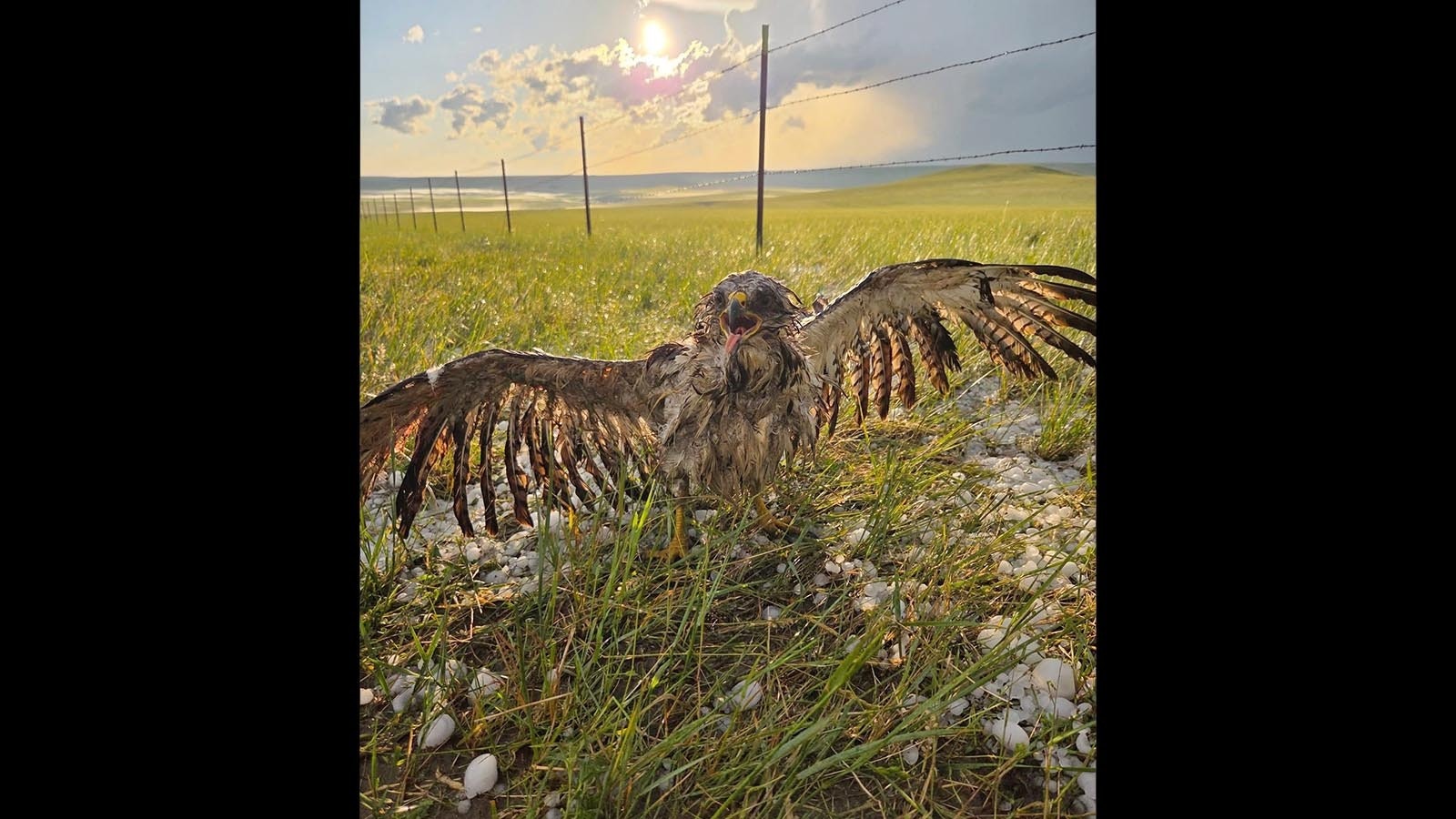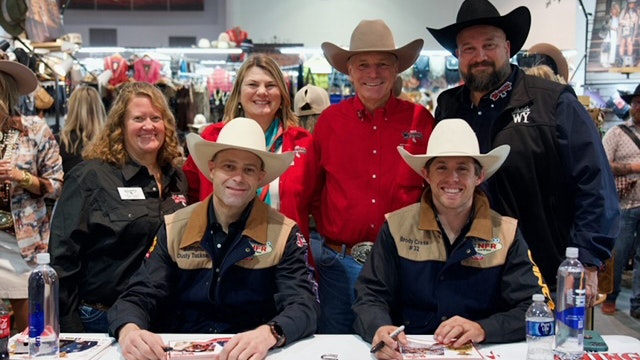A surge of supercell thunderstorms over the last week has pummeled Wyoming, Montana and Colorado with golf ball- to baseball-sized hail that’s obliterated windshields, tore pieces off of homes and killed wildlife.
Haden Wichman was branding calves near Kolin, Montana, on Saturday evening when he saw dark storm clouds on the horizon.
“We went up the road to watch it, because we knew the big white cloud was going to come down the creek bottom,” he told Cowboy State Daily. “It was like a flash flood of golf ball-sized hail and 2 inches of rain that came with it.”
After 30 minutes of heavy rain and hail, the skies cleared and Wichman ventured back out to his property. That's when he came across a shocking sight: a battered hawk that had been caught up in the furious hailstorm.
“It was sitting right by the gate, all hunched over,” he said. “I could see that the feathers on his wings were all broken. He wasn’t able to fly.”
Wichman couldn’t do anything for the injured bird at that moment, as it was getting late and he had to check on his cattle. When he returned to the same spot later, the hawk was gone.
None of Wichman’s cattle were lost to the hailstorm, but evidence of its destruction was everywhere.
“All the siding and windows on the south-facing houses were broken out,” he said. “I saw a lot of birds, Hungarian (partridges) and meadowlarks, and even some coyotes that didn’t make it. That hawk might have made it, or he might not have.”
Hailstorm Season
Another thunderstorm in southeast Montana caused widespread destruction Monday. Areas around Billings, Montana, reported as much as 8 inches of hail that covered the ground like a heavy snowfall.
Similar reports of baseball-sized hail came out of the Denver metropolitan area in Colorado. Several people lost windows in their vehicles in the ferocity of Monday’s thunderstorms.
“Yesterday was not a good day if you were an insurance agent,” said Cowboy State Daily meteorologist Don Day. “We had a lot of 1- to 2-inch hail reported in Douglas and Converse counties northeast of Cheyenne, and parts of Goshen County near Torrington.
“A lot of hail reports, but nothing as big as what was seen in Montana and Colorado.”
Supercells
Hail forms as moisture gets sucked into the updraft of a thunderstorm and stays in the freezing zone of storm clouds long enough that water droplets start to freeze. The duration of their stay in the freezing zone determines how big the hail can get.
Day said the widespread destruction across Colorado and Montana was caused by supercell thunderstorms. These “rotating thunderstorms” are smaller but more severe than “garden-variety” thunderstorms.
“Supercells evolve and change,” he said. “They move along at a pretty good clip, 25-35 mph, intensifying and rapidly move through an area, then falling apart just as quickly as they form. You get more forming throughout the heat of the afternoon, and once the atmosphere settles down in the late afternoon, you'll see them dissipate."
Any thunderstorm can produce hail, but supercells are notorious for producing massive hailstones, heavy rain and strong winds. Some can even gain enough momentum to turn into tornadoes.
Summer is the season for supercells and hail. Day said there are two distinct periods when Wyoming and the rest of the Rocky Mountain region are particularly susceptible to hail.
In fact, southeast Wyoming is so prone to hailstorms it’s been dubbed “Hail Alley.”
“The first phase is in June, which is the transition from getting out of spring into summer,” he said. “The air loft is still a little cool and we've got good, low-level moisture.
“Then, we wait for the next pattern that brings moisture up from the southwestern United States, which we call the North American Monsoon, that gets the thunderstorms generating again.”
The moisture from the North American Monsoon can increase the frequency of supercell thunderstorms from mid-July to the beginning of September. That’s another prime hailstorm season, although Day believes the June phase might be worse.
“Hail can happen at any time of year, but June in particular can be a nasty month for hailstorms in this part of the country,” he said.

Garage And Green Cloud Season
When it rains, it pours. And when it hails, there’s a risk of short-term injury followed by long-term financial hardship.
Wichman said he was fortunate that his livestock were OK. The rest of the ranch wasn’t spared.
“We lost close to 250 acres of hay ground and close to 1,000 acres of pasture in the strip where the hailstorm went through,” he said. “All the structures and vehicles that got damaged are insured, but the pasture and some of that hay ground aren’t.”
Summer might be hailstorm season, but it should also be garage season. That’s Day’s advice for mitigating the damage of hail.
“I always tell people that this is the time of year you want to have room in your garage or room to put your car or possessions you don't want shredded by hail,” he said. “You’ve got to be aware at this time of year, and a lot of people's garages are full of crap other than cars.”
Any thunderstorm can produce hail, so Wyomingites are fortunate to have resources like the National Weather Service’s Storm Prediction Center (SPC). Day said that’s the best resource to anticipate any potential incoming hail.
“The SPC will predict the probability of hail up to three days in advance, and they try to highlight parts of the country that have a hail risk,” he said. “That’s your best way to assess your risk.”
Beyond that, there aren’t any reliable signs of imminent hail that are indistinguishable from a standard supercell thunderstorm. The only possible indicator Day is aware of is an occasional color in the clouds.
“There are a lot of times that hail will cause a cloud to have a greenish hue to it,” he said. “A lot of that depends on the sun angle and the time of day, but if you look up at a cloud and see that it's dark or greenish-colored, that could be a hailstorm.”
The Part Of The World We Live In
The hailstorms over the last week have been intense. Wichman got a familial perspective on the scope of the destruction in central Montana.
“My dad's 73,” he said. “He’s been here his whole life and said he's never seen anything like it before.”
Day said hailstorms are something Wyomingites should accept as an unavoidable hazard of living in the Cowboy State. In his words, hail is like wind in Wyoming.
“We’re in a target-rich environment for wind and hail,” he said. “We have the right topography, climate and everything else to get a higher frequency of both, and this is the time of year when the risk of hail is at its highest.”
Andrew Rossi can be reached at arossi@cowboystatedaily.com.





